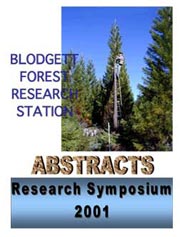 |
||||||||||||||
|
||||||||||||||
| 2001 Blodgett Forest Research Symposium |
| Research Projects | Research Publications | Back to TABLE OF CONTENTS |
|
|||||
Understanding the effects of harvest and site preparation practices on long-term nutrient dynamics in forest plantations is required to ensure long-term sustainability in these intensively-managed systems. Two levels of soil compaction (SC) and forest floor removal (FFR), were used to assess their impact on tree growth, N uptake and N status on ponderosa pine in plantations on soils of different textures. Tree growth results showed that in the site with loamy soil, compaction was beneficial to tree growth if the forest floor was retained. Compaction effect was not significant with forest floor removed. In clayey soil SC depressed tree growth in the absence of forest floor. In sandy loam soil, SC positively influenced growth in the absence of forest floor. The recovery of isotopically-labeled N fertilizer in foliage of the upper crown was clearly detectable at all the sites. In loamy and clayey soils, SC positively influenced recovery if the forest floor was present, but no significant effects of compaction on N uptake were observed with total removal of the forest floor. In sandy-loam, the contribution of SC to the variation of recovery was significant in both conditions, with and without forest floor. Results for the loamy and clayey sites suggest that in compacted soils, when the litter was retained, SC favored N uptake through improved unsaturated water flow and root:soil contact or decreased microbial activity. In sandy soils the positive effects of compaction on N uptake may have been influenced by increased soil pore connectivity. |
|||||
Contact Author: William R. Horwath, Land, Air, and Water Resources, University of California, Davis, One Shields Avenue, Davis, CA 95616-8627, (530) 784-6029, wrhorwath@ucdavis.edu Thais Winsome, Armando Gomez-Guerrero, Michael J. Singer Land, Air & Water Resources, University of California, Davis Robert F. Powers USDA Forest Service, Pacific Southwest Research Station |
|||||
|
|||||
|
University of California Center for Forestry, UC Berkeley. Last modified: 6/27/02 ©Copyright, 2001. The Regents of the University of California. For questions and comments, contact webmaster. |
